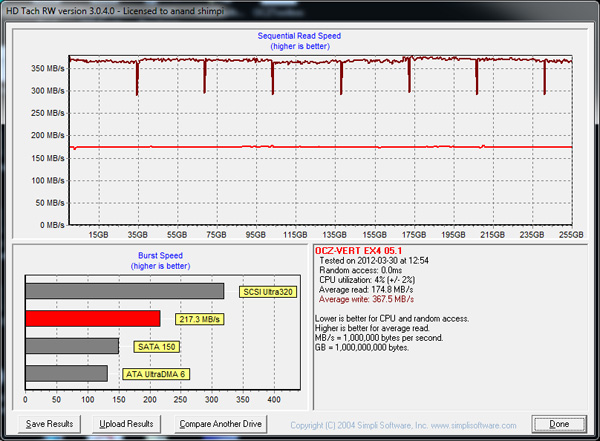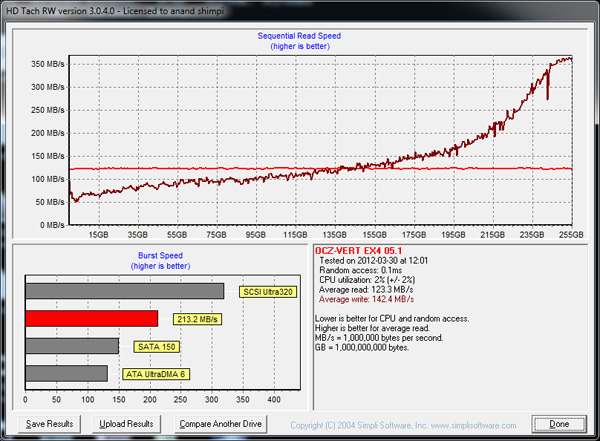OCZ Vertex 4 Review (256GB, 512GB)
by Anand Lal Shimpi on April 4, 2012 9:00 AM ESTTRIM Performance
I started out this review with a mention of estimated write amplification and how OCZ was able to significantly reduce it with the Vertex 4/Everest 2 compared to Octane/Everest 1. By reducing write amplification, OCZ should have also significantly improved worst case write performance when TRIM isn't available or before it's able to act.
To find out, I wrote sequential data across all user addressable LBAs and then wrote random data (4KB, QD=32) for 20 minutes across all LBAs. Finally I used HDTach to give me a simple visualization of write performance across all available LBAs (aka the Malventano Method):
This is a huge improvement over what we saw with the Octane. Behavior here isn't quite what we see with Intel's controllers, but again it's a huge step above what we saw in the previous generation.
The Vertex 4 does support idle time garbage collection, but at very low priority. The drive must be idle for at least an hour for the background GC to kick in. I'm glad to see that OCZ has taken a more conservative route here as I've never been a huge fan of idle time garbage collection to begin with.
If you don't leave the drive alone long enough to trigger the idle GC, as soon as 85% of the blocks on the drive are used up the Vertex 4 will automatically trigger its garbage collection algorithms. This is more of what I'd like to see, however I'd prefer it even more if OCZ lowered the limits of when it would start recycling blocks in order to try and maintain good performance under heavily fragmented conditions.
TRIM is alive and well on the drive – a single TRIM pass is able to restore performance to new:












127 Comments
View All Comments
Coup27 - Friday, April 6, 2012 - link
For the uneducated, what is a referral link?ginman - Wednesday, April 4, 2012 - link
I have been reading articles here for some number of years now and i like reading these. But i notice it's normally the same players, Intel, OCZ, Samsung, Crucial ect... I was wondering if there has been any benches run on the Mushkin SSD's, pricewise; they seem to be setting a new trend.InsaneScientist - Wednesday, April 4, 2012 - link
What's up with the connector on the opposite end of the board from the SATA connector? It looks like the same pinout as SATA, but smaller.Did I miss an interface specification?
And, more importantly: what's it for? 2 interfaces on one drive?
pc_void - Wednesday, April 4, 2012 - link
More like for sale ON amazon.Amazon itself isn't selling it atm.
And the prices are stupid.
sfroom - Wednesday, April 4, 2012 - link
I just reread the Samsung 830 review based on your comment in the last paragraph, but could barely find any mention of Mac use in the review. Why is the Samsung 830 your SSD of choice for Mac users?Additionally, I'd LOVE to see an article comparing the current batch of SSD's on the mac platform. Thanks!
ectoplasmosis - Wednesday, April 4, 2012 - link
I second this.ckryan - Wednesday, April 4, 2012 - link
The 830 pretty much works trouble free in OSX, with or without TRIM. It's garbage collection on post-CXM01B1Q FW is good, and performance got a bump with it too.Samplex - Thursday, April 5, 2012 - link
Why is this: "If you're buying an SSD today, our standarding recommendation (particularly for Mac users) is Samsung's SSD 830."Why is the Samsung better for mac users?
7Enigma - Thursday, April 5, 2012 - link
See here:http://www.anandtech.com/show/4863/the-samsung-ssd...
But as ckryan said above it comes down to garbage collection and TRIM support (or lackthereof).
iceman98343 - Thursday, April 5, 2012 - link
You can purchase the drive at amazon now - http://goo.gl/p8BSK